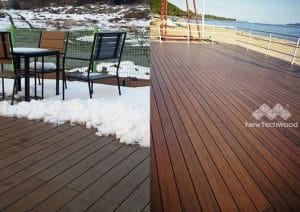Many people dream of living on the coast, envisioning long bare-foot walks on white sands, magnificent sunsets (or sunrises) glistening over the ocean, swimming and surfing the waves, luxuriating in those glorious summer evening breezes… and, of course, beach parties!
If you’re considering coastal living, your first decision may well be whether to build new or renovate an older home. Each has its pros and cons, and here are some points to consider:
Location
Obviously, you want to take advantage of properties offering the best view, but how exposed and vulnerable is it? Is there protection against winter storm surges, or is there potential for major flooding or other costly damages?
Renovating
If choosing to renovate, is the layout functional as-is, or will many structural changes be required? Look for a property with good “bones” – a healthy pre-existing structure that will be able to handle reconstruction works and won’t collapse around you if you want to knock out a wall.
Views and Ventilation
Take advantage of views and cooling sea breezes with large windows or sliding doors. If the sun is going to beat down on those windows all day, however, consider a shade structure to protect the windows or use window glazing, both which will help keep your home cooler.
Moisture and Mould
Coastal living means that mould could develop from the extra moisture in the air. You need to keep your environment dry, and increased airflow throughout the home will assist. Design your house or renovations to enable the free movement of the sea breeze. Open-plan living is ideal for this, as are long centre hallways running from the front of the house to the back that will carry the cool breeze throughout your home.
Cleaning Up After Cooling Off
 For beachside living, one current fad is timeless, and one may even say essentially: an outdoor shower.
For beachside living, one current fad is timeless, and one may even say essentially: an outdoor shower.
Best that your swimmer and surfer shower off before entering the house, rather than traipsing half the beach in with them.
(This outdoor shower was built with NewTechWood.)
Flooring
Avoid wall-to-wall carpets. Tiled or timber floorboards will make cleaning easier (think of the beach sand). These flooring types will also help keep the house cooler and drier and will prevent any potential mould problems stemming from moisture.
Building Materials
Use materials that are corrosive resistant and that can withstand the sun, salt exposure, strong winds, moisture, and sand, and especially materials that are less prone to mould. For example, you can buy hypoallergenic plasterboard to line walls and ceilings that are both moisture and mould-resistant.
With timbers, make sure you select the right timber for the job as well as the location. Some timbers contract and expand more than others, some are suitable for in-ground use and others are not. If you do use natural timbers, make sure they are treated correctly to withstand the elements. Also, try to use timbers that are native to your area because they will already be acclimatised.
Discuss with your builder ways of combining timber with other materials to avoid maintenance, sanding and repainting, which will be an ongoing issue. Make sure materials that will be more affected by the location will be restricted to use in areas that are less exposed. Don’t forget to also use appropriate fixings that won’t rust or corrode.
Decking, Cladding & Screening
In fact, why not avoid all the problems associated with natural timber and consider a composite timber product instead.
For example, NewTechWood’s range of decking, cladding, screen and fencing products. NewTechWood looks like real timber and is made from 60% recycled timber and 40% recycled plastic, so you know it’s environmentally friendly.
and is made from 60% recycled timber and 40% recycled plastic, so you know it’s environmentally friendly.
It is protected 360 degrees by a strong polymer capping, making it resistant to Australia’s harsh environmental conditions. It’s ideal for use in the northern tropics, in the snowfields, and right next to the beach.
Significantly, it is UV and fade-resistant – vital for our climate – and termite resistant. But even more important, it is moisture and mould-resistant. It also won’t cup, split or warp and you never need to sand, reseal or repaint it – ever. Top this off with a 25-year residential warranty and you can see the attraction this very natural-looking composite product has over natural timber. It is perfect for coastal living!
Be Green and Maintenance Free
In addition to energy-efficient appliances, consider solar panels, solar hot water systems, grey water systems, water-efficient fixtures, and make sure your home is insulated. Select garden plants that are suitable for coastal environments and will need little attention.
Finally, choose a builder who is familiar with the location and special building conditions. After all, you want to enjoy your new lifestyle by the sea and not spend all your spare time cleaning and maintaining your property. Another great reason for choosing NewTechWood!
For more information on our weather-resistant decking, please find your local supplier or contact our friendly team today.

